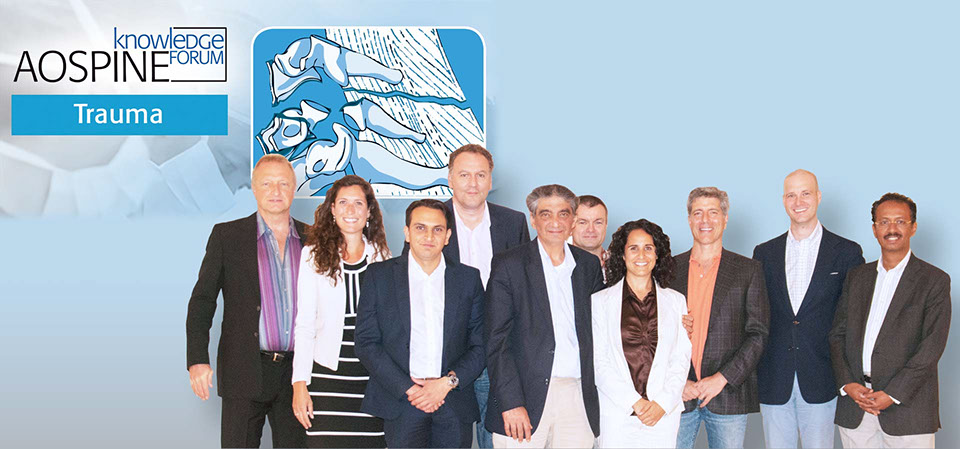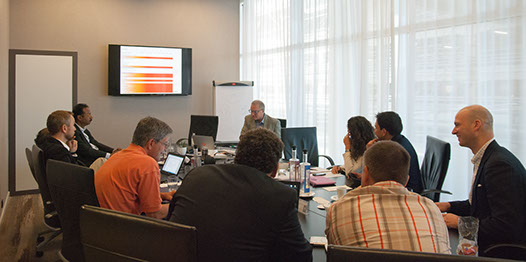feature storY
Global Spine Congress Focus
HIGHLIGHTS
MEET THE AOSPINE MEMBERS

AOSpine Knowledge Forum Trauma focuses on controversies in spine trauma
Despite fast improvement in injury assessment and surgical techniques in spine trauma in recent years, controversies remain. To address this, the AOSpine Knowledge Forum Trauma (KF Trauma) recently published a Focus Issue in the Journal of Orthopaedic Trauma (JOT). Principal Investigator (PI) Alex Vaccaro and Co-PI Gregory Schroeder felt a framework of best evidence for current best practices was needed. A focus issue made it possible to bring together knowledge produced by KF Trauma studies under one heading for greater impact and stimulate thought into further questions that should be asked.
Six key areas addressed
"We wanted to give the reader the possibility to sit down with one source in their hand and find answers", Vaccaro explains. "We looked at important areas in the spine, from the atlas and upper cervical spine to the pelvis; critical issues such as does the timing of surgery matter; or what are the controversies or "We wanted to give the reader the possibility to sit down with one source in their hand and find answers."weaknesses in the Classification System."
Once the key questions had been defined, study groups led by a KF Steering Committee member invited a wide representation of renown international surgeons to collaborate, to debate and discuss, to find consensus, and to come up with evidence-based recommendations. The results of this year long international process are the Focus Issue.
Traumatic injuries have a relative low incidence, but their influence on an individuals' social, functional, and financial situation and on health-related costs is high. In this context, six controversial areas were identified in the management of spine trauma: the role and timing of medical and surgical interventions for patients with associated neurologic injury; type and timing of surgical stabilization for multiply injured patients; the role of non-surgical versus surgical treatment; the role of different surgical approaches and techniques; methods of nonoperative management; and care of elderly patients with concurrent complex disorders. The KF Trauma successfully addresses these areas in the Focus Issue.
Spreading the word beyond the spine community
By publishing in the JOT, as opposed to a spine only journal, KF Trauma hopes to reach a wider audience. "Most high-level spine articles are published in highly "Our goal is to publish impactful manuscripts that help address challenges in medicine. The open access Focus Issue allows researchers to reach a large group of surgeons and pass on their knowledge."specified and narrowly circulated journals", Schroeder explains. "Our goal is to publish impactful manuscripts that help address challenges in medicine. The open access Focus Issue allows researchers to reach a large group of surgeons and pass on their knowledge."
AOSpine Knowledge Forum Trauma is uniquely positioned. "Often study groups are focused on few surgical procedures. Ours is really the only global study group looking at spine trauma", Schroeder says and points out that spine trauma and spinal cord injury are becoming increasingly common through the world.
The group is enjoying a major success and growing impact from the AOSpine Subaxial and Thoracolumbar Classification Systems, also covered in the current Focus Issue. Of the 12 papers, Schroeder and Vaccaro further highlight the current controversies in spinal trauma and spinal cord injury; the effect on outcome of formal laminectomy and timing of decompression for patients with sacral fracture and neurologic deficit; and the paper on fractures in spinal ankylosing disorders.
Led by the spirit of discovery
Moving forward, one big topic is managing geriatric patients with spinal fractures. KF Trauma is already developing a classification for patients with osteoporosis, to look at how osteoporotic bone modifies the application of the fractures or treatment of the patient, while standard fixation techniques in use may not be applicable.
"It's fascinating!" Vaccaro says plunging into other complex topics. "Say you have a pelvic fracture with a sacral fracture; just operating on them can be challenging for both patient and family." As always, the scientist in him calls "In the spirit of discovery and with the global network of AOSpine, we continue to survey the state of existing controversies and help spine clinicians provide better care."for evidence: "We think operating on a patient with a neurologic deficit benefits the patient in a setting of a burst fracture. I think it does–but show me the evidence! We have not been able to give robust evidence."
The wish list for new studies is long. "We all tend to look at things differently", Vaccaro continues. "If we could have an application that uses artificial intelligence and deep learning to identify a fracture, label it for the physician, and help them with an algorithm of care, that would be phenomenal."
"In the spirit of discovery and with the global network of AOSpine, we continue to survey the state of existing controversies and help spine clinicians provide better care", Schroeder sums up. Vaccaro and Schroeder expect to build on their current results and produce another focus issue in a year's time, putting findings into clinically meaningful context, and developing outcome measures that allow to understand when interventions have really changed the outcome of the patient.
For the open access KF Trauma Focus Issue, go to:
![]() journals.lww.com/jorthotrauma
journals.lww.com/jorthotrauma
For more information on KF Trauma, go to:

The KF Trauma at work, Amsterdam, the Netherlands, 2015.
Articles from the Focus Issue referred to in the above article
- Oner C, Rajasekaran S, Chapman JR, Fehlings MG, Vaccaro AR, Schroeder GD, Sadiqi S, Harrop J. Spine Trauma-What Are the Current Controversies? J Orthop Trauma 31 Suppl 4(S)1-6, 2017.
- Ahuja CS, Schroeder GD, Vaccaro AR, Fehlings MG. Spinal Cord Injury-What Are the Controversies? J Orthop Trauma 31 Suppl 4(S)7-13, 2017.
- Rustagi T, Drazin D, Oner C, York J, Schroeder GD, Vaccaro AR, Oskouian RJ, Chapman JR. Fractures in Spinal Ankylosing Disorders: A Narrative Review of Disease and Injury Types, Treatment Techniques, and Outcomes. J Orthop Trauma 31 Suppl 4(S)57-74, 2017.
- Kepler CK, Schroeder GD, Hollern DA, Chapman JR, Fehlings MG, Dvorak M, Bellabarba C, Vaccaro AR. Do Formal Laminectomy and Timing of Decompression for Patients with Sacral Fracture and Neurologic Deficit Affect Outcome? J Orthop Trauma 31 Suppl 4(S)75-80, 2017.
Authors
AOSpine Knowledge Forum Trauma Steering Committee
F. Cumhur Oner, University Medical Center Utrecht, Utrecht, the Netherlands
Alexander R. Vaccaro, The Rothman Institute, Thomas Jefferson University, Philadelphia, PA, USA
Frank Kandziora, BG Unfallklinik Frankfurt am Main, Frankfurt, Germany
Jens R. Chapman, Swedish Medical Center, Seattle, WA, USA
Shanmuganathan Rajasekaran, Ganga Hospital, Coimbatore, India
Marcel Dvorak, University of British Columbia, Vancouver, BC, Canada
Klaus John Schnake, Schön Klinik Nürnberg Fürth, Fürth, Germany
Lorin Benneker, Inselspital, University of Bern, Switzerland
Emiliano N. Vialle, Cajuru Hospital, Catholic University of Paraná, Curitiba, Brazil
AOSpine Knowledge Forum Trauma Associate Member
Gregory D. Schroeder, The Rothman Institute, Thomas Jefferson University, Philadelphia, PA, USA
Collaborators
Michael G. Fehlings, University of Toronto, ON, Canada | Bizhan Aarabi, University of Maryland, MD, USA | Brian K. Kwon, University of British Columbia, Vancouver, BC, Canada | Carlo Bellabarba, University of Washington School of Medicine, Seattle, WA, USA | Christopher K. Kepler, Thomas Jefferson University, Philadelphia, PA, USA | Said Sadiqi, University Medical Center Utrecht, Utrecht, the Netherlands | Rishi Mugesh Kanna, Ganga Hospital, Coimbatore, India | Mechteld Lehr, University Medical Center Utrecht, Utrecht, the Netherlands | Christopher S. Ahuja, University of Toronto, Toronto, ON, Canada | Noori Akhtar-Danesh, McMaster University, Hamilton, ON, Canada | Tarush Rustagi, Swedish Neuroscience Institute, Seattle, WA, USA | Doniel Drazin, Swedish Neuroscience Institute, Seattle, WA, USA | Jonathan York, University of Tennessee Medical Center, Knoxville, TN, USA | Rod Oskouian, Swedish Neuroscience Institute, Seattle, WA, USA | Scott C. Wagner, The Rothman Institute, Thomas Jefferson University, Philadelphia, PA, USA | Douglas A. Hollern, The Rothman Institute, Thomas Jefferson University, Philadelphia, PA, USA | So Kato, Toronto Western Hospital, Toronto, ON, Canada | Jean-Christophe Murray, Toronto Western Hospital, Toronto, ON, Canada | Hamadi Murphy, The Rothman Institute, Thomas Jefferson University, Philadelphia, PA, USA | Mark F. Kurd, The Rothman Institute, Thomas Jefferson University, Philadelphia, PA, USA | Andrew N. Fleischman, The Rothman Institute, Thomas Jefferson University, Philadelphia, PA, USA | Matti Scholz, BG Unfallklinik Frankfurt am Main; Frankfurt, Germany | Weilong J. Shi, The Rothman Institute, Thomas Jefferson University, Philadelphia, PA, USA | Alexander J. Schupper, The Rothman Institute, Thomas Jefferson University, Philadelphia, PA, USA
Newsletter 16 | April 2018
Newsletter 16 April 2018
feature storY
Global Spine Congress Focus
HIGHLIGHTS
MEET THE AOSPINE MEMBERS